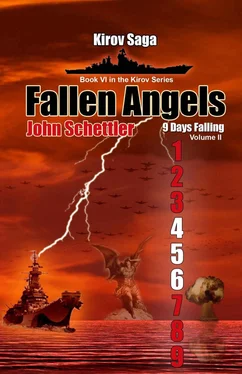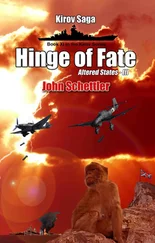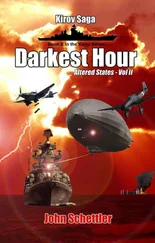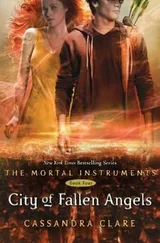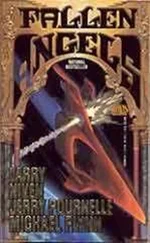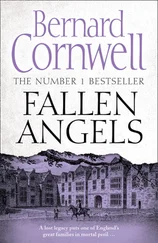He wondered what he would do if something happened to Karpov. How should he carry on the fight? What if it came down to that same desperate moment that had prompted Karpov to use nuclear weapons? Would he have the guts to do the same?
“Well I am not going to sit here and wait for the planes to show up like a bad weather front on our radar screens, Rodenko. The instant I see them forming over those carriers, I’m going to attack. If one of those ships spots us before that, I’ll blow it out of the water.”
“Aye, sir,” Rodenko said quickly, yet he could feel and hear the edge in Karpov’s voice. Everyone on the bridge could feel it too.
Rodenko glanced at the ship’s chronometer. It was only a matter of time before the Americans got close enough to spot them. Then the planes would come—perhaps more planes than they had missiles. There would be carnage in the skies for a wild hour…Then something would get through.
“Sir, Captain Yeltsin on Orlan requests battle orders.”
Karpov looked at Nikolin, a sallow expression on his face.
“Tell him I am going to hit the Americans here,” he was still looking at the tactical board as he pointed. “On their right flank.” Tell him that we will begin the action ourselves, and assign him his targets. I have moved the KA-226 to a position to allow us to better identify what we are shooting at. I’m going to punch a hole in their line right here, and sink whatever I have to in order to do so. Signal Admiral Golovko that they should keep their helos aloft on active ASW watch. Go to active sonar. I want no surprises.”
“Very well, sir.”
Rodenko was watching the long range radar returns now, noting the refresh of the screen as the system updated at intervals. Then he experienced a thrum of anxiety, for he saw what looked like a definite concentration of smaller contact returns to the south. His radar man saw it as well and turned to report, but Rodenko raised a hand, silencing him. He would deliver the bad news himself.
“Captain, I believe I have long range returns on air units forming to the south.”
He saw Karpov’s eyes shift quickly to him from the tactical board. The Captain licked his lips, as though he were very thirsty, needing water and sustenance. His right hand strayed to his brow, and he rubbed a spot above his eyebrow. There was no clasping of his hands behind his back this time. His chin was not elevated and his eyes seemed dark and smoldering, not bright and alive as Rodenko had often seen him in combat. There was no instruction to begin a log entry to commence the action, with all the drama Rodenko remembered when they had engaged the battleship Yamato . Karpov had the look of a man who was about to fight his last great battle, confident but wary and burdened by a strange feeling of presentiment, like Napoleon at Waterloo. There was just a moment’s hesitation, and then he spoke, his voice low, yet firm.
“Mister Samsonov. P-400s. Long range barrage in two batteries of eight. We are going to spoil their party.”
“Aye, sir. Keying targets and ready to fire.”
“How many will that leave us?”
“Sixteen on the P-400s, sir.”
“Sixteen? Oh yes… We fired half the entire inventory against the Americans in 2021. We’ll use the remainder now in 1945, and hit them before they have the slightest inkling of any danger. Perhaps we can pluck this weed out by the root this time, before it flowers.”
A last whisper of recollection came to Karpov now. It was Volsky speaking to Doctor Zolkin just after he had laid out his plan of attack against the British.
“I told you this man was one of the best tactical officers in the fleet, Doctor.”
“Yes,” said Zolkin . “He has the bravery of being out of range. It’s very comfortable—but just a little a bit devious at the same time.”
Yes, just a little bit devious, thought Karpov. What else should one expect from a Fallen Angel?
Theline swept north for two long hours, covering just over 50 nautical miles in that time. Halsey had three radar pickets out in front of the main skirmish line, but they were having fits with their radars. So the orders went out to man every weather deck and crow’s nest with eyes, and it was down to binoculars again, and the hope of a clear horizon.
Destroyer escort Fox was out in front, making 30 knots as she raced north. The seas had been heavy behind them, driven by the gales of a budding typhoon to the south, but now the wave sets were lower, swells evening out, skies clearing ahead. Named for a gallant Marine Lieutenant, the Myles C. Fox , DD-829, was a latecomer to the war, a Gearing class boat that had been fitted out with the latest radars for picket duty. She arrived in mid-August just after hostilities had ceased.
Commander John S. Fahy was at the helm, a bit rattled over the fact that none of his radar equipment was in working order. He had come over from USS Gillespie , DD-609, where he saw action in the Solomons and Peleliu campaigns, so he was no stranger to combat. The screens were clouded over, and he quickly deduced the enemy must be jamming them.
“They’re close, Pem,” he said to his XO Pemberton Southard. “I can feel it. Double up on the lookouts. I can smell a good fight coming, and soon.”
“Aye, sir.” Southard was a competent man who was just a little disappointed that the ship was late to the action in the Pacific. The Japanese had surrendered when they were off Wake Island, and he boasted it was because they knew the Myles C. Fox was coming. He didn’t quite know what to make of the rumor that they were up here looking for Russians now, and that broiling mushroom cloud northwest of their position that morning was an ominous and disheartening thing to watch. All the men on the bridge were tense and alert. They could sense trouble coming too.
Ensign Pine was the first to make a report. “Look to starboard, sir. Lookouts report a contrail.”
Commander Fahy had his binoculars up just in time to see it. Something descending from a bank of clouds and diving for the sea. It was coming right for the ship and he immediately gave the order hard left and ahead full for an evasive turn. The ship had plenty of boiler power in reserve for the sudden burst of additional speed, but the missile could not be fooled by such a rudimentary maneuver. It bored in and struck the destroyer flush on the forward deck behind the number one gun mount, setting her afire with a shuddering impact.
Fires broke out in the passageway around number two upper handling room, in the forward officer’s room, the anchor windless room, and on the number one gun mount itself. The Forward Repair Officer and half of initial repair party on the scene were killed or wounded by secondary explosions. Fahy was on the handset immediately ordering additional damage control crews forward. There they found a ruptured fire main and began to rig out new hoses from fireplugs on the main deck to fight the flames.
The enemy was close, alright. Commander Fahy had the presence of mind to sight down the line of approach of the missile and send off a good estimate of the ship’s bearing relative to his own position. The contrail had also been sighted by a second destroyer picket, Chevalier , and together the two ships began to triangulate. Ten minutes later they thought they had a good idea where the enemy was. It wasn’t enough to sent a “ship sighted” message, but Fahy insisted the information be passed on to Halsey on the Missouri .
It cost them seven dead and thirty-two injured, and Fox was forced to fall off the line and retire after her first salt drenched smell of gunpowder, but Halsey had what he wanted. He knew where the enemy was and he was pouring on the speed. The word went out on the wireless to all ships in the line, and soon they were altering course to intercept based on a presumption that the enemy was still headed east.
Читать дальше
